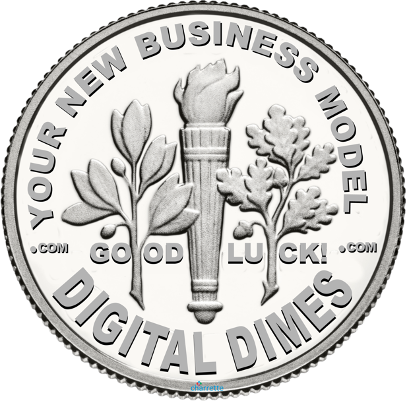
For those whose businesses have been temporarily or forever altered by the sudden collapse of in-person everything, let me offer the experiences of a recovering media executive. As you shift from products and services from the physical to the digital realm, your customers and clients will inevitably want to pay less. Perhaps far less.
Welcome to your new business model: Digital dimes.
When we launched the print version of Inter@ctive Week Magazine in 1994 (“The Internet’s newspaper”), Tim Berners-Lee’s World Wide Web was in its infancy. State-of-the-art online access was through a pokey 2,400-bits-per-second modem, and our publication website’s gorgeous graphics took an agonizing amount of time to download.

So did our online ad sales.
Sure, we were one of the first magazines online. But as editor-in-chief, I was appalled to hear from our salespeople that advertisers wanted their ads atop the home page of our website. Who would sanction such an abomination? That would be like smearing an ad on our newsmagazine cover.
Worse, advertisers wanted to pay less for bits than they did for atoms. A lot less. In fact, depending on where the ad appeared on the site, they were willing to pay about a tenth of the rate for print ads, or less.
That’s why dejected online ad salespeople throughout the industry began echoing a rueful mantra: “From analog dollars to digital dimes.” And, later on: from digital dimes to social-media pennies.
As the Internet ate media, it dawned on print publishers that they would soon have to run their businesses on a fraction of their former revenue. New media entrants like Huffington Post and Buzzfeed, which built themselves from the digital ground up for a hyper-lean model, thrived. But traditional media could only desperately cut costs ahead of plummeting revenue. That’s why the old media workforce became the first Internet-era jobpocalypse, with employment today less than half what it was 25 years ago.

As we collectively stumble into what I call Phase Two of the Great Reset, continually adapting to an uncertain period of new consumer and business behavior, here are several challenges you’ve probably already met head on, no matter what industry you’re in:
- Most of your workers began operating from home, and your expensive office or campus became a substantial cost center.
- Your competitors rapidly moved as much of their offerings online as possible. The result was an avalanche of options for customers, with the noise level suddenly dialed up to 11. (How many virtual events have you been invited to lately?)
- For your new more virtual offerings, customers only want to pay digital dimes. Or perhaps they initially only wanted to pay digital zero.
As we turn the pandemic/recovery lights back on, with confusing rules in every city and state, the fog on the digital highway keeps us from knowing when and how place-based markets will return. Will customers now want products and services delivered in person, online, or in some hybrid offering? That uncertainty holds true for cruises and colleges as much as for concerts and conventions.
But if the historic Big Shift in media offers useful signposts, you can expect more competition, from farther away, as the frictions of the analog world are removed. You’ll see faster change, as your most-nimble competitors adapt their offerings. And of course, you’ll see continuous downward pressure on price, as customers seek cheaper offerings of equivalent value.
So, here are three recommendations.
- Co-create relentlessly. Your customers are likely working to understand their needs just as hard as you are. A continuous dialog won’t just help you meet the needs of your current customers. In the immortal words of Charlene Li, author of “The Disruption Mindset,” it will help you prepare for your future customer.
- Iterate continuously. History says that constant experimentation is needed during these shifts to determine what customers will actually pay for. Hybrid models blending in-person and online are likely the new abnormal. But in what mix? Keep experimenting.
- Revamp your costs. Those who can operate on digital dimes will have far more flexibility than those who are still trying to scale back businesses dependent on analog dollars.
Of course, it’s easy for me to say that your restaurant should get by on half the revenue. Or your movie theater needs to optimize for a third of the audience. Or that your college needs to unbundle education and become a hybrid learning factory. Those physical assets may not be able to even approach generating your traditional revenue as they did before, for at least a year or two. So an adapted business model will need to make up for the drop in traditional revenue.
We are all in uncharted territory, a period of breathtaking uncertainty buffeted by incomplete science, rapidly-shifting rules and norms, and demand that is literally unpredictable. Depending on where you operate, in-person everything could come roaring back – and then a sudden virus flareup could change the rules overnight.
I hope there will be many colleges and conferences and sports events and tourist destinations for many years to come. I hope that every existing business dependent on analog customers will continue to adapt and thrive. We know from early Internet history that once an industry accelerates down the digital highway, countless new opportunities appear around each bend.
But the organizations that will thrive are those that realize this is not some change-management drill, heading toward some mythical future static state. Change management is dead. What’s left is managing perpetual change.
So should you try to reinforce your existing business model with your current cost structure? Or should you rapidly move to co-create new digital offerings?
I wish I had a dime for every time I’ve been asked that.
Gary A. Bolles is the Chair for the Future of Work for Singularity University. You can follow him on LinkedIn.














